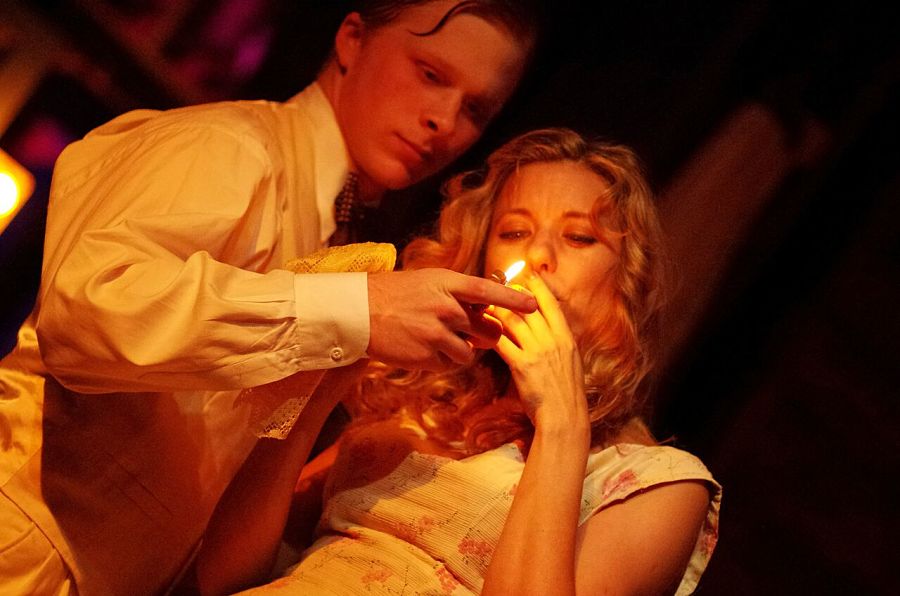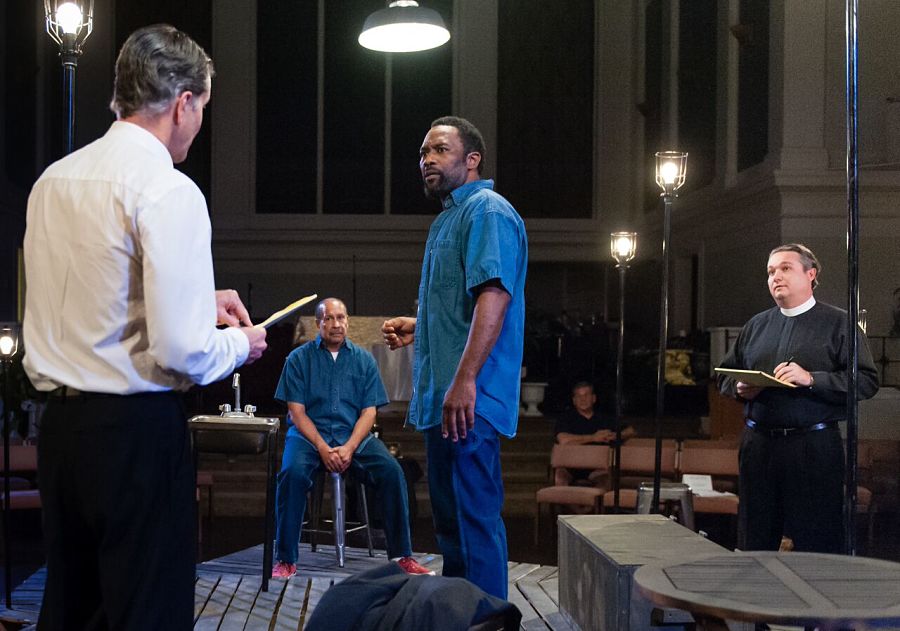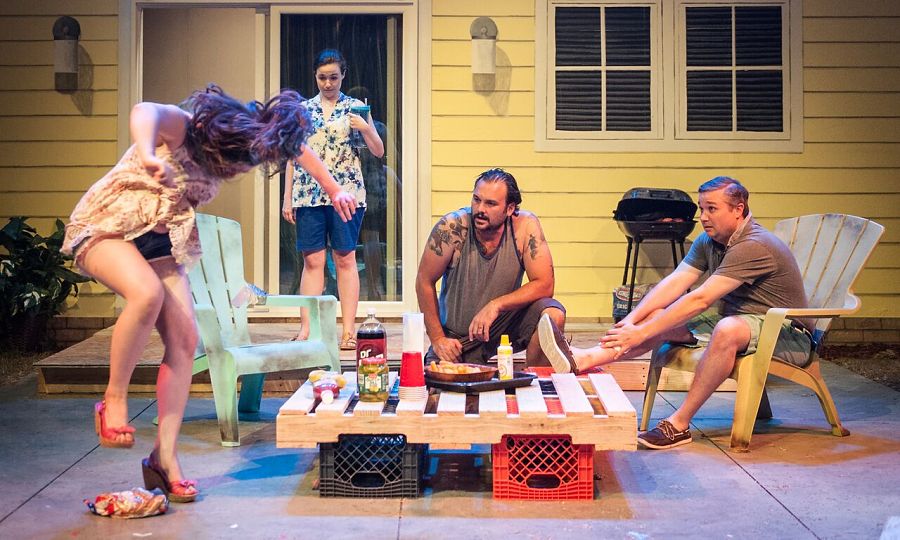When Aimée Hayes played A Streetcar Named Desire’s Blanche DuBois, Tennessee Williams’s famously downbeat drama about the decadent South got a lot more laughs than you’re probably accustomed to. In Hayes’s incarnation, the play’s desperate, tapped-out, unstable heroine was clearly at the end of her rope, but she could still deliver a one-liner with aplomb.
“I think one of the best things about the kind of Southern women Williams wrote is that they’re wickedly funny,” says Hayes, who is the producing artistic director—and occasional leading lady—of the New Orleans–based company Southern Rep Theatre. “They’re the most cynical women on earth! They sit back and smile, and that allows them to be left alone, in a way, observing human nature and commenting on it.”
Hayes, who was born in New Orleans and has headed the city’s best known professional theatre company since 2008, is obviously in the right place to grapple with Williams’s vision—which she has done repeatedly, as director, actor, and producer, during her Rep tenure. In addition to A Streetcar Named Desire, mounted in 2012—virtually on location, in an unused former funeral home at the corner of Elysian Fields Avenue and Chartres Street, approximating Williams’s poetic placement of the Kowalski apartment—Hayes has staged a trio of little-known Williams one-acts (The Magic Tower, The Pretty Trap, and Every Twenty Minutes) in 2011; played Hannah Jelkes in The Night of the Iguana in 2014; and directed a critically acclaimed Suddenly, Last Summer, timed to coincide with last season’s annual Tennessee Williams/New Orleans Literary Festival.
She’ll next mount Williams’s Orpheus Descending, March 12–April 3, on the campus of the University of New Orleans (UNO). “This is a huge project for us, with lots of moving parts,” says Hayes, who has relinquished the show’s directorial duties to Minneapolis-based Jef Hall-Flavin. “I wanted to produce this one,” Hayes says, “because that allows me to be involved in every aspect of the production.” She won’t perform in it, though: The cast includes veteran stage and film actor Brenda Currin, who anchored Suddenly, Last Summer as Violet Venable, and who seems committed to Southern Rep as something of a theatrical home.
Williams’s women, not surprisingly, are what especially fascinate Hayes, a remarkably youthful 49. “Sure, Blanche’s life is miserable and hard and painful,” she ventures, “but she finds joy in little things—in the wonderful pleasures of the flesh, in sexuality. And face it—desire is funny!”
Iguana’s hard-luck spinster Hannah, on the other hand, did not tickle the actor’s funny bone. “Playing Hannah is the toughest thing I’ve ever done onstage,” she confesses. “I’d come off the stage every night weeping. I read that Tennessee thought that if Blanche weren’t a drinker, she’d be Hannah. Maybe, but I’d much rather have a little booze in my Coca-Cola and march off at the end of the play with a handsome doctor.” Indeed, in Southern Rep’s staging, Streetcar’s “kindness of strangers” doctor was a hunk; who wouldn’t be tempted to rely on that brand of generosity?

But while Williams is a staple for New Orleans audiences, Hayes’s programming at the Rep has been anything but one-note. Indeed, she has been a champion of new-play development, attracting a coterie of fans for laboratory readings and monthly “play slams” of work by local writers. The same impulse generated Boudin: The New Orleans Music Project, a rousing, crowdsourced musical collage about the spiritually redemptive properties of Crescent City music, directed last spring by Sean Daniels, who now holds the reins of Massachusetts’s Merrimack Repertory Theatre. Hayes herself has directed the regional premieres of such contemporary properties as Venus in Fur, Red, In the Next Room (or the vibrator play), The Clean House, Grey Gardens, and—in partnership with San Francisco’s Magic Theatre and a quartet of fellow directors—Taylor Mac’s drag epic The Lily’s Revenge. Some of that work—everything since January 2012, in fact—has been accomplished with a prodigious handicap. Since that date, Southern Rep has been homeless.
For most of its first 19 years, the company, founded in 1986 by scholar and sometime playwright Rosary O’Neill, had been ensconced in Canal Place, a multilevel shopping center at the foot of Canal Street, the dividing line between the city’s historic Vieux Carré and its central business district. But that arrangement ended abruptly with a canceled lease, leaving the company reeling.
“Canal Place was a blessing and a curse,” Hayes says now. “The downside was that there was no interaction with the community—we were cocooned within the engine of commerce! So leaving Canal Place was at first exciting and exhilarating, then exhausting, infuriating, frustrating. Still, if it hadn’t happened, we would never have done Streetcar across the street from where Stella and Stanley would actually have lived; we’d never have begun our Tennessee Williams walking tours; we’d never have taken our shows to new environments and to new parts of the city. It’s been a great learning experience, but along the way people became exhausted by the constant moving.”

Hayes has accordingly become obsessed with the search for a permanent space for the road-weary company; promising negotiations for three different venues have fallen through in the past two years. But now there’s finally light at the end of the tunnel: To her overdue relief, the theatre has signed an agreement to move its operations into an unused church/school complex in one of the city’s most historic neighborhoods. “It’s a fantastic place,” she enthuses, “located at one of the city’s crossroads, the crux of Treme, Bayou St. John, and Esplanade Avenue.
“We’ve never gotten this far before,” she adds with cautious enthusiasm. “The church, St. Rose of Lima, got in touch with me last February about coming to see the space.” The space is owned by Rose Community Development Corporation, and they’re working with New York City’s Alembic Community Development, whose mission is to put nonprofits into renovated or rediscovered historic buildings; Alembic did the same for the Myrtle Banks Building in New Orleans’s Central City, which now houses galleries and workspaces for artists. But, she notes, “There are lots of moving parts to this undertaking, like providing parking, making sure the neighborhood is ready, and so on.”
Within the vaulted church building, topped by a graceful marble statue of the 17th-century saint who gives the church its name (and whose image, incidentally, is featured on the highest-denomination banknote of Peru), the Rep plans to create a mainstage space, a black box theatre, a café, rehearsal rooms, and a shop; there’ll be an outdoor performance space as well.
“New Orleans is so temperate,” Hayes notes, “we should always be doing outdoor things, like pre-show events.” Both indoor theatres will be small. “I don’t want a 250-seat theatre,” she avows. “We want everybody close to the action. The idea is to get back to the concept of telling stories around the fire—I want spaces that feel welcoming and comfortable to do that in.”
The transition to a permanent home won’t be cheap. When Hayes and her board revealed the Rep’s plan to the public (on Feb. 18, shortly after this year’s early Mardi Gras on Feb. 9), they simultaneously launched a $1.5 million capital campaign. “I’ll be making lots of speeches and pitches over the next couple of years,” Hayes concedes, taking a deep breath. “We’re aiming to move into the building in 2018, fill in the month.”
That means the company will be itinerant for another season and a half—during which there’ll be another major Williams production, Sweet Bird of Youth, as well as the first local staging of Lisa D’Amour’s Airline Highway, the bittersweet valentine to New Orleans that debuted at Chicago’s Steppenwolf Theatre Company and made a strong impression in its truncated six-week Broadway run last season. D’Amour’s ambitious opus, with its 20-plus cast, elaborate roadside set, and musical demands, will once again benefit from the Rep’s working relationship with UNO. “Their thrust stage is the only one in town we figured we could fit a car on,” Hayes deadpans.
Playwright D’Amour, a fellow Louisianian who divides her time between the Big Easy and Brooklyn, is a frequent Rep collaborator—Hayes directed the regional premiere of her Detroit at the Rep last year—and a Hayes enthusiast.
“Aimée is like a cross between a magical Mardi Gras fairy sprite and Yoda’s secret half-sister,” D’Amour offers with a grin. “Her deep knowledge of New Orleans and her commitment to what the city needs just floors me season after season.”
Still, even with eventual stability for her company ensured, the long hunt for a space has taken a toll on Hayes. “You’d probably have to describe me as depressed, despite the good news,” she says ruefully. “This is the fourth process like this we’ve gone through, and there’s a lot of work ahead.” She has physical challenges as well. “I have Crohn’s disease, which is a lifetime illness. I’ve had it since I was 18. It manifests in fatigue, fever, weight loss (even though I eat like a maniac). It tends to make me a hermit sometimes. I go through cycles when I don’t feel good for a year or two.” Still, she says, “I’m smiling through my grumpiness—I don’t want anything to keep me from doing what I want to be doing. I’m pretty ornery that way.”
Hayes sees herself as a late bloomer—“I didn’t get out of college till my late 20s,” she says with a shrug—and something of a nomad. “I went away from New Orleans so many times; as I was growing up, we lived all over the country,” she recalls. “I’ve had a peripatetic upbringing, having been raised not exactly by hippies, but by wanderers, you could say.” She moved back to New Orleans from NYC with a year left to go on an MFA at Tulane; she called her mentor, the late Buzz Podewell, who headed the college’s directing program. “I said, ‘Can I come down and finish my degree?’ He said, ‘Come on, kid!’” She finished her studies at age 39. “I don’t even consider myself a mid-career director—I’m just now about to step into that,” she says. “I’m affording myself the time to keep learning.”
Her first hookup with Southern Rep came in 2007, when she took on the job of managing director under then–artistic director Ryan Rilette. “I’ve done marketing, press, sales—management was my day job, but I had the commitment to direct one show a year,” Hayes recalls. When Rilette decided in 2008 to move on to a leadership post at California’s Marin Theatre Company, there was a national search and Hayes got the job.

She’s learned a lot about her hometown in the seasons since—not all of it good. Support for the arts, in particular, isn’t exactly flowing like the Mississippi.
“When our mayor, Mitch Landrieu, was lieutenant governor of the state, he worked to take the face of New Orleans and put the word ‘culture’ above it, to say to everybody around the world, ‘This is us!’—rebranding us not as just Bourbon Street but as a place of culture: JazzFest, the Saints, food, wine, theatre, ballet, opera, all elevated,” Hayes says. “But there’s a disconnect between talking about art and actually funding that art. When I tell my colleagues around the country how much our state arts council distributes each year to all its grantees, they laugh, because often they’ve gotten that amount from their arts councils just for themselves!”
Louisiana funders have shown more commitment in recent years to venue renovation, most notably that of the centrally located, lavishly restored Saenger Theatre, now a year-round concert hall and Broadway touring venue, and the Joy Theater, a former movie palace across Canal Street that specializes in high-profile musical attractions. Hayes isn’t resentful.
“These great old theatres are places that have an emotional connection to most of us in our lifetimes, and they needed to come back,” she concedes. Still, she says, “There needs to be an examination of what our larger theatre ecology is, too. We need the smaller theatres, storefronts, second-tier companies. We’re trying to speak to the communities we’re in—that’s the golden ticket, the height that we aspire to.”
That aspiration got full-fledged expression in the fall of last year with Hayes’s premiere production of a Louisiana-based drama called Song of a Man Coming Through, about the state’s harsh treatment of death-row inmates, based on the real-life case of convicted murderer Earnest Knighton Jr., a black man, and the two white lawyers who tried unsuccessfully to save him from what Joe Morris Doss and Andrew Doss’s play called an “arbitrary and capricious” death sentence. Staged in the sanctuary of a racially mixed Methodist Church on Canal Street, with gumbo and gospel music in the lobby, the play galvanized and polarized audiences in equal measure, and showcased Hayes’s directorial audacity in a remarkable final sequence in which Knighton, played by the magnetic actor Robert Diago DoQui, was ritualistically robed and anointed with oils in preparation for the electric chair. The Times-Picayune dubbed the show one of 2015’s theatrical highlights.
“New Orleanians have always deeply identified with the idea of community being part of theatre,” Hayes posits, “which is what you see in the history of Le Petit.” She’s referring to Le Petit Théâtre du Vieux Carré, the jewel box of a venue at one corner of Jackson Square, which was founded in 1916 and once proudly tagged itself “the oldest continually operating community theatre in the U.S.” After struggling mightily with money problems in recent years, Le Petit is on an ambitious new path under recently imported artistic director Maxwell Williams, who characterizes the retooled company as “a professional theatre with deep community ties.”
“When you think about all the people who’ve gone through Le Petit’s doors from childhood—they cherish the idea of community theatre, which, let’s face it, is completely different from commercial or regional theatre,” Hayes says. It’s an ethos she thinks is at the heart of local theatre. “Despite the brief success of the old Repertory Theatre of New Orleans, which lasted just a few years in the late ’60s and early ’70s, this city has never been a place deeply identified with regional theatre. I know that’s changing, but the love of Le Petit goes back five generations, so this idea of what theatre is supposed to be is in our DNA.”
Hayes and her theatrical colleagues are also concerned about the Balkanization of New Orleans audiences: Companies like the Rep, Le Petit, the NOLA Project, ArtSpot Productions, and the city’s busy cluster of ensembles all have their followings, but there’s very little audience crossover. Does she have a recipe for changing those dynamics?
“Southern Rep and other companies are doing regional-theatre quality work here, but we can’t abandon that sense of letting the community in,” Hayes insists. “I’ve sat in on Lear deBessonet’s Odyssey, part of the Public Works programming at the Public Theater in New York—that kind of exciting work is what we’re eager to do at Southern Rep. We want to open the doors and welcome in the community, to allow newcomers to theatre a chance to experience its force.”
It’s possible that for the first time Hayes will have just the setup she needs to make it happen: a theatre-and-arts-education campus of her own, situated under the watchful gaze of St. Rose of Lima, right in the heart of Tennessee Williams’s favorite city.
American Theatre founding editor Jim O’Quinn is now based in New Orleans.


